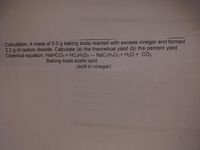
Chemistry
10th Edition
ISBN: 9781305957404
Author: Steven S. Zumdahl, Susan A. Zumdahl, Donald J. DeCoste
Publisher: Cengage Learning
expand_more
expand_more
format_list_bulleted
Concept explainers
Question

Transcribed Image Text:HEVTIH 6BEWINW b
Calculation. A mass of 5.0 g baking soda reacted with excess vinegar and formed
2.2 g of carbon dioxide. Calculate (a) the theoretical yield (b) the percent yield
Chemical equation: NaHCO3+ HC2H3O2→ NaC2H3O2+ H2O + CO2
Baking soda acetic acid
(acid in vinegar)
WEW
EHITHEVTIR
Expert Solution
This question has been solved!
Explore an expertly crafted, step-by-step solution for a thorough understanding of key concepts.
This is a popular solution
Trending nowThis is a popular solution!
Step by stepSolved in 3 steps

Knowledge Booster
Learn more about
Need a deep-dive on the concept behind this application? Look no further. Learn more about this topic, chemistry and related others by exploring similar questions and additional content below.Similar questions
- 3KOH+H3PO4⟶K3PO4+3H2O what mass of phosphoric acid in grams is needed to produce 2.15 mol of water?arrow_forwardConsider the reaction 3X + 2Y → 5C + 4D How many moles of C can be synthesized from 23.0 moles of Y and excess X?arrow_forwardHeptacarbon octahydride is an effective gasoline additive. In the presence of oxygen gas (and a spark), it undergoes complete combustion.(b) Calculate the theoretical yield of water (in g) when 500.0 g of heptacarbon octahydride reacts with excess O2.arrow_forward
- peact Baking soda is often included in recipes to make food rise. When heated, it will produce sodium carbonate, water vapor, and carbon dioxide. Which of the five types of chemical reactions does the equation represent? Provide evidence and reasoningarrow_forwardFor the reaction: 2C2H5COOH + 7O2 -> 6CO2 + 6H2O Calculate the number of moles of O2 required to react with 29.616 grams C2H5COOH.arrow_forwardThere are two steps in the extraction of copper metal from chalcocite, a copper ore. In the first step, copper(I) sulfide and oxygen react to form copper(I) oxide and sulfur dioxide: →+2Cu2Ss 3O2g + 2Cu2Os 2SO2g In the second step, copper(I) oxide and carbon react to form copper and carbon monoxide: →+Cu2Os Cs + 2Cus COg Suppose the yield of the first step is 86.% and the yield of the second step is 64.% . Calculate the mass of copper(I) sulfide required to make 2.0kg of copper. Be sure your answer has a unit symbol, if needed, and is rounded to the correct number of significant digits.arrow_forward
- 11.) Combining 0.204 mol Fe₂ 03 with Carbon produced 18.7 excess 18.7'g Fe 4 C Fe₂O3 + 30→2Fe + 3 Co What is the actual yield of iron in moles? what is the theoretical yield of iron in moles? What is the percent gield?arrow_forwardFor the following reaction: C3Hg(g) + O2(g) ————> CO2(g) + H2O(g) a). balance the reaction b). determine the limiting reactant from 20.0 grams for each starting reactant c). calculate the theoretical yield of CO2(g) in grams d). calculate the percent yield if the actual yield was 10.7 gramsarrow_forwardBalance each reaction, then suppose exactly 13.3 g of each reactant is taken. Indicate which reactant is the limiting reagent. Calculate the mass of each product that is expected. (c) NaOH(s) + CO2(g) → Na2CO3(s) + H2O(l)limiting reagent? NaOHCO2 Na2CO3 produced g H2O produced garrow_forward
- Consider the reaction 3X + 2Y → 5C + 4D How many moles of C can be synthesized from 37.0 moles of Y and excess X?arrow_forwardBalance and complete the following combustion reaction. Give the sum (one number only) t e t r a c a r b o n h e x a h y d r i d e ( g ) + o x y g e n ( g ) ⟶ ?arrow_forwardThe rocket boosters of the space shuttle Discovery, launched on July 26, 2005, used a fuel mixture containing primarily solid ammonium perchlorate, NH4ClO4, and aluminum metal. The unbalanced chemical equation for the reaction is given below. (Hint: Balance the elements in the order Cl, H, O, Al, N.) Al(s) + NH4CIO4(s) Al₂O3(s) + AlCl3(s) + H₂O(l) + N₂(g) What is the mass (in kilograms) of NH4ClO4 consumed per kilogram of Al, assuming a percent yield of 87.20%? (Answer with two decimal places.)arrow_forward
arrow_back_ios
SEE MORE QUESTIONS
arrow_forward_ios
Recommended textbooks for you
 ChemistryChemistryISBN:9781305957404Author:Steven S. Zumdahl, Susan A. Zumdahl, Donald J. DeCostePublisher:Cengage Learning
ChemistryChemistryISBN:9781305957404Author:Steven S. Zumdahl, Susan A. Zumdahl, Donald J. DeCostePublisher:Cengage Learning ChemistryChemistryISBN:9781259911156Author:Raymond Chang Dr., Jason Overby ProfessorPublisher:McGraw-Hill Education
ChemistryChemistryISBN:9781259911156Author:Raymond Chang Dr., Jason Overby ProfessorPublisher:McGraw-Hill Education Principles of Instrumental AnalysisChemistryISBN:9781305577213Author:Douglas A. Skoog, F. James Holler, Stanley R. CrouchPublisher:Cengage Learning
Principles of Instrumental AnalysisChemistryISBN:9781305577213Author:Douglas A. Skoog, F. James Holler, Stanley R. CrouchPublisher:Cengage Learning Organic ChemistryChemistryISBN:9780078021558Author:Janice Gorzynski Smith Dr.Publisher:McGraw-Hill Education
Organic ChemistryChemistryISBN:9780078021558Author:Janice Gorzynski Smith Dr.Publisher:McGraw-Hill Education Chemistry: Principles and ReactionsChemistryISBN:9781305079373Author:William L. Masterton, Cecile N. HurleyPublisher:Cengage Learning
Chemistry: Principles and ReactionsChemistryISBN:9781305079373Author:William L. Masterton, Cecile N. HurleyPublisher:Cengage Learning Elementary Principles of Chemical Processes, Bind...ChemistryISBN:9781118431221Author:Richard M. Felder, Ronald W. Rousseau, Lisa G. BullardPublisher:WILEY
Elementary Principles of Chemical Processes, Bind...ChemistryISBN:9781118431221Author:Richard M. Felder, Ronald W. Rousseau, Lisa G. BullardPublisher:WILEY

Chemistry
Chemistry
ISBN:9781305957404
Author:Steven S. Zumdahl, Susan A. Zumdahl, Donald J. DeCoste
Publisher:Cengage Learning

Chemistry
Chemistry
ISBN:9781259911156
Author:Raymond Chang Dr., Jason Overby Professor
Publisher:McGraw-Hill Education

Principles of Instrumental Analysis
Chemistry
ISBN:9781305577213
Author:Douglas A. Skoog, F. James Holler, Stanley R. Crouch
Publisher:Cengage Learning

Organic Chemistry
Chemistry
ISBN:9780078021558
Author:Janice Gorzynski Smith Dr.
Publisher:McGraw-Hill Education

Chemistry: Principles and Reactions
Chemistry
ISBN:9781305079373
Author:William L. Masterton, Cecile N. Hurley
Publisher:Cengage Learning

Elementary Principles of Chemical Processes, Bind...
Chemistry
ISBN:9781118431221
Author:Richard M. Felder, Ronald W. Rousseau, Lisa G. Bullard
Publisher:WILEY